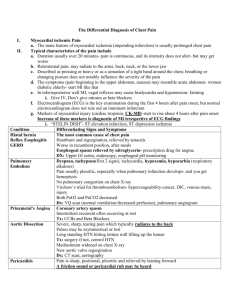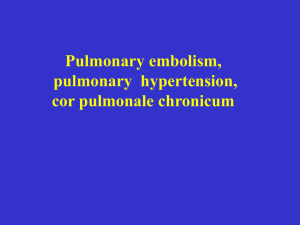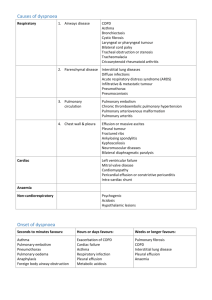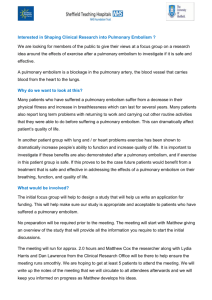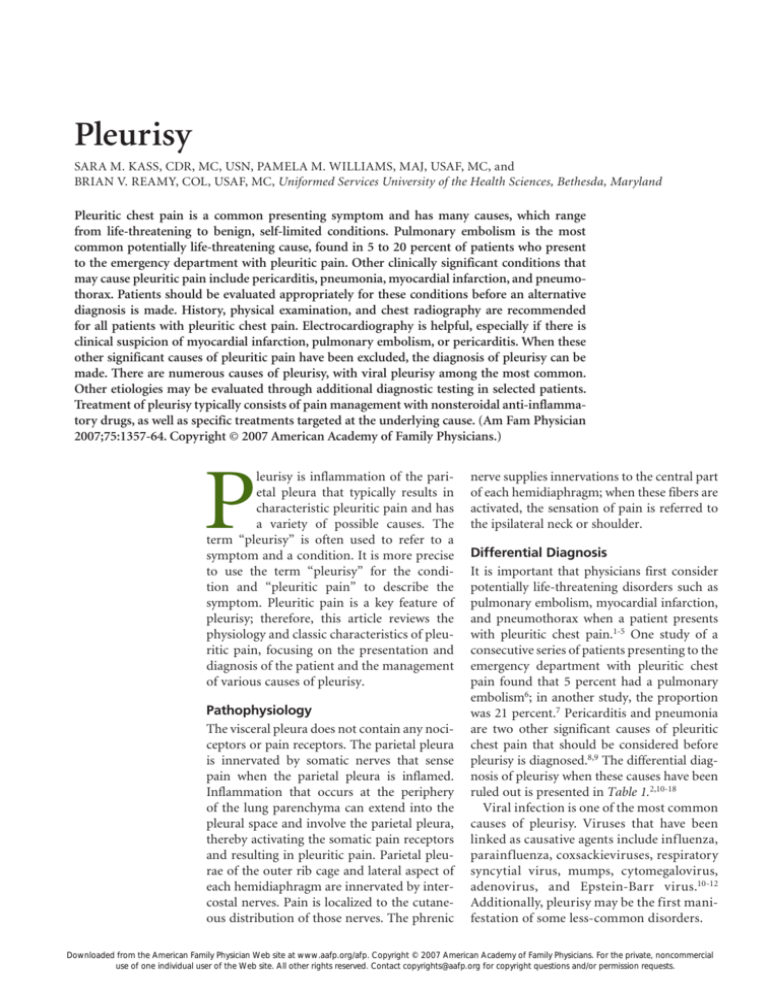
Pleurisy
SARA M. KASS, CDR, MC, USN, PAMELA M. WILLIAMS, MAJ, USAF, MC, and
BRIAN V. REAMY, COL, USAF, MC, Uniformed Services University of the Health Sciences, Bethesda, Maryland
Pleuritic chest pain is a common presenting symptom and has many causes, which range
from life-threatening to benign, self-limited conditions. Pulmonary embolism is the most
common potentially life-threatening cause, found in 5 to 20 percent of patients who present
to the emergency department with pleuritic pain. Other clinically significant conditions that
may cause pleuritic pain include pericarditis, pneumonia, myocardial infarction, and pneumothorax. Patients should be evaluated appropriately for these conditions before an alternative
diagnosis is made. History, physical examination, and chest radiography are recommended
for all patients with pleuritic chest pain. Electrocardiography is helpful, especially if there is
clinical suspicion of myocardial infarction, pulmonary embolism, or pericarditis. When these
other significant causes of pleuritic pain have been excluded, the diagnosis of pleurisy can be
made. There are numerous causes of pleurisy, with viral pleurisy among the most common.
Other etiologies may be evaluated through additional diagnostic testing in selected patients.
Treatment of pleurisy typically consists of pain management with nonsteroidal anti-inflammatory drugs, as well as specific treatments targeted at the underlying cause. (Am Fam Physician
2007;75:1357-64. Copyright © 2007 American Academy of Family Physicians.)
P
leurisy is inflammation of the parietal pleura that typically results in
characteristic pleuritic pain and has
a variety of possible causes. The
term “pleurisy” is often used to refer to a
symptom and a condition. It is more precise
to use the term “pleurisy” for the condition and “pleuritic pain” to describe the
symptom. Pleuritic pain is a key feature of
pleurisy; therefore, this article reviews the
physiology and classic characteristics of pleuritic pain, focusing on the presentation and
diagnosis of the patient and the management
of various causes of pleurisy.
Pathophysiology
The visceral pleura does not contain any nociceptors or pain receptors. The parietal pleura
is innervated by somatic nerves that sense
pain when the parietal pleura is inflamed.
Inflammation that occurs at the periphery
of the lung parenchyma can extend into the
pleural space and involve the parietal pleura,
thereby activating the somatic pain receptors
and resulting in pleuritic pain. Parietal pleurae of the outer rib cage and lateral aspect of
each hemidiaphragm are innervated by intercostal nerves. Pain is localized to the cutaneous distribution of those nerves. The phrenic
nerve supplies innervations to the central part
of each hemidiaphragm; when these fibers are
activated, the sensation of pain is referred to
the ipsilateral neck or shoulder.
Differential Diagnosis
It is important that physicians first consider
potentially life-threatening disorders such as
pulmonary embolism, myocardial infarction,
and pneumothorax when a patient presents
with pleuritic chest pain.1-5 One study of a
consecutive series of patients presenting to the
emergency department with pleuritic chest
pain found that 5 percent had a pulmonary
embolism6; in another study, the proportion
was 21 percent.7 Pericarditis and pneumonia
are two other significant causes of pleuritic
chest pain that should be considered before
pleurisy is diagnosed.8,9 The differential diagnosis of pleurisy when these causes have been
ruled out is presented in Table 1.2,10-18
Viral infection is one of the most common
causes of pleurisy. Viruses that have been
linked as causative agents include influenza,
parainfluenza, coxsackieviruses, respiratory
syncytial virus, mumps, cytomegalovirus,
adenovirus, and Epstein-Barr virus.10-12
Additionally, pleurisy may be the first manifestation of some less-common disorders.
Downloaded from the American Family Physician Web site at www.aafp.org/afp. Copyright © 2007 American
Academy of Family Physicians. For the private, noncommercial
use of one individual user of the Web site. All other rights reserved. Contact copyrights@aafp.org for copyright questions and/or permission requests.
Pleurisy
SORT: KEY RECOMMENDATIONS FOR PRACTICE
Clinical recommendation
A thorough history and physical examination should be performed
to diagnose or exclude life-threatening causes of pleuritic pain
before making a diagnosis of pleurisy.
Pulmonary embolism is the most common life-threatening cause of
pleuritic chest pain and should be considered in all patients with this
symptom. Evaluation should be performed using validated clinical
decision rules, d -dimer testing, and imaging studies as needed.
Patients with pleuritic pain should have chest radiography to
evaluate for underlying pneumonia.
Nonsteroidal anti-inflammatory drugs should be used to control
pleuritic pain.
Evidence
rating
References
C
3, 9, 19, 22, 29
C
19
C
9
B
30, 31
A = consistent, good-quality patient-oriented evidence; B = inconsistent or limited-quality patient-oriented evidence; C = consensus, disease-oriented evidence, usual practice, expert opinion, or case series. For information
about the SORT evidence rating system, see page 1289 or http://www.aafp.org/afpsort.xml.
Table 1. Differential Diagnosis of Pleurisy*
Category
Etiology
Cardiac
Post–cardiac injury syndrome, post–myocardial infarction
syndrome (Dressler’s syndrome), postpericardiotomy
syndrome (postcommissurotomy syndrome)
Exposure
Asbestosis, some medications†
Inflammatory bowel disease, spontaneous bacterial
pleuritis
Familial Mediterranean fever
Malignancy, sickle cell disease
Gastrointestinal
Genetic
Hematologic/
oncologic
Infectious
Inflammatory
Renal
Rheumatologic
Viral (e.g., adenovirus, coxsackieviruses,
cytomegalovirus, Epstein-Barr virus, influenza,
mumps, parainfluenza, respiratory syncytial virus)
Bacterial (e.g., Mediterranean spotted fever,
parapneumonic or tuberculous pleuritis)
Parasitic (e.g., amebiasis, paragonimiasis)
Reactive eosinophilic pleuritis
Chronic renal failure, renal capsular hematoma
Lupus pleuritis, rheumatoid pleuritis, Sjögren’s syndrome
*—Assumes pulmonary embolism, myocardial infarction, pneumothorax, pericarditis, and pneumonia have been ruled out as the cause of pleuritic chest pain.
†—Drugs known to cause pleural disease include amiodarone (Cordarone), bleomycin
(Blenoxane), bromocriptine (Parlodel), cyclophosphamide (Cytoxan), methotrexate, methysergide (Sansert; not available in the United States), minoxidil (Loniten),
mitomycin (Mutamycin), oxyprenolol (Apsolox; not available in the United States),
practolol (Eraldin; not available in the United States), procarbazine (Matulane), and
sclerotherapeutic agents. Drugs that may cause lupus pleuritis include hydralazine
(Apresoline), procainamide (Pronestyl), and quinidine.
Information from references 2 and 10 through 18.
1358 American Family Physician
www.aafp.org/afp
Presentation
Patients with pleuritic pain present in different ways depending on the underlying cause.
Pleuritic pain typically is localized to the area
that is inflamed or along predictable referred
pain pathways. Patients’ descriptions of the
pain are consistent in most cases of pleurisy.
The classic feature is that forceful breathing
movement, such as taking a deep breath,
talking, coughing, or sneezing, exacerbates
the pain.
Patients often relate that the pain is sharp
and is made worse with movement. Typically, they will assume a posture that limits
motion of the affected area. Pain with respiration may cause patients to complain of
shortness of breath or dyspnea.
Evaluation
A recommended approach for the evaluation
of patients presenting with pleuritic chest
pain is given in Figure 1.3-5,8,9,19-22 Evaluation
of patients in whom pulmonary embolism
is suspected should include an assessment
of the probability of pulmonary embolism
using a validated clinical decision rule, such
as the Wells rule,19 and a d-dimer test. Computed tomography or ventilation-perfusion
scanning may be required in patients who
are at moderate or high risk or who have an
abnormal d-dimer test result.20
Volume 75, Number 9
◆
May 1, 2007
Pleurisy
Outpatient Diagnosis of Pleuritic Pain
Patient presents with pleuritic pain
History and physical examination
Chest radiography
Normal
Abnormal
Clinical suspicion for MI, pulmonary
embolism, or pericarditis?
Infiltrate
No
Yes
Pleural
separation
Cardiomegaly
Pneumonia
Pneumothorax
ECG
Normal
Consider
pericarditis,
perform ECG
Abrupt hilar
cutoff, oligemia, or
pulmonary infarct
Consider
pulmonary
embolism*
Abnormal
Persistent clinical suspicion of MI?
No
Yes
Obtain enzymes
Persistent clinical suspicion
of pulmonary embolism?
MI, obtain cardiac
enzymes
No
Yes
Persistent clinical
suspicion of pericarditis?
Consider pulmonary
embolism*
No
ST-segment elevation,
new Q wave, new
conduction defect
Sinus tachycardia,
RV overload
Consider
pulmonary
embolism*
Diffuse concave
upward ST-segments,
PR-segment depression
Pericarditis
Yes
Clinical suspicion of less common
cause for pleurisy (see Table 4)?
Observe, consider NSAIDs
Yes
No
Viral pleurisy
Proceed with further diagnostic evaluation (as in Table 4)
This algorithm combines and simplifies diagnostic recommendations from multiple sources to provide an overview and does not represent a
validated clinical decision rule.
note:
*—Apply Wells decision rule to assess pretest probability, order d -dimer and interpret in light of pretest probability, then order further testing as
recommended by that diagnostic algorithm.19,20
Figure 1. Algorithm for the outpatient diagnosis of pleuritic pain. (MI = myocardial infarction; ECG = electrocardiography;
RV = right ventricular; NSAIDs = nonsteroidal anti-inflammatory drugs.)
Information from references 3 through 5, 8, 9, and 19 through 22.
May 1, 2007
◆
Volume 75, Number 9
www.aafp.org/afp
American Family Physician 1359
Pleurisy
Table 2. Etiologies of Pleuritic Pain
by Symptom Onset
medical history
A careful, focused history is the first step in
identifying the underlying etiology of pleuritic pain. A key question is the time course
of the onset of symptoms (Table 22).
Although pleuritic pain decreases the likelihood that a patient with chest pain is
experiencing myocardial ischemia, it does
not eliminate the possibility.3 If other history findings suggest this diagnosis, further
evaluation with electrocardiography (ECG)
and cardiac enzymes, as well as close observation, is indicated. Pain that worsens while
the patient is supine and lessens while the
patient is upright should prompt consideration of pericarditis.8,21 Dyspnea associated
with the pain should raise clinical suspicion
for pulmonary embolism, pneumonia, and
pneumothorax.5,9,23
Features that are associated with lifethreatening causes of pleuritic pain are listed
in Table 3.3-5,8,9,21,22 Other symptoms, such as
malaise, weight loss, night sweats, and joint
Onset
Etiologies
Acute
(i.e., minutes
to hours)
Myocardial infarction
Pulmonary embolism
Spontaneous pneumothorax
Trauma
Infection
Inflammatory process
Subacute
(i.e., hours
to days)
Chronic
(i.e., days
to weeks)
Malignancy
Rheumatoid arthritis
Tuberculosis
Familial Mediterranean fever
Recurrent
Information from reference 2.
pains, may indicate one of the less-common causes of pleurisy. It is important to
investigate the patient’s underlying medical conditions, medication list, and recent
travel history, and to take a history of similar
symptoms in family members. A selected
differential diagnosis with associated clinical results is listed in Table 4.13-18,24-27
Table 3. Findings Associated with Life-Threatening Causes of Pleuritic Pain
Diagnosis
History
Physical examination
Chest radiography
Electrocardiography
Myocardial
infarction
Substernal pain that
radiates, dyspnea,
shortness of breath
Pleuritic pain decreases
likelihood ratio
Positional pain: increases
while supine and
decreases when upright
Diaphoresis, hypotension,
third heart sound (S3)
Usually normal
ST-T elevations (especially
if new), new Q wave,
new conduction defect
Pericardial friction rub
Increased heart size
with pericardial
effusion greater
than 250 mL
Anorexia, cough, dyspnea,
fatigue, myalgia
Sudden pain and dyspnea
Crackles, egophony,
fremitus
Tachycardia, hyperresonance,
decreased breath sounds,
decreased wall movement
Infiltrate
Diffuse concave upward
ST-segments, PRsegment depression
Abnormality noted in more
than 90 percent of cases
Typically not indicated
Prior embolism or clot
Cancer, immobilization,
estrogen use, or recent
surgery
Dyspnea, syncope
Tachycardia, tachypnea
Pericarditis
Pneumonia
Pneumothorax
Pulmonary
embolism
Thin pleural line
May be normal in
small pneumothorax
Abrupt hilar
cutoff, oligemia,
or pulmonary
consolidations
compatible with
infarction
Typically not indicated
Sinus tachycardia
Sinus tachycardia, right
ventricular overload
(T-wave inversion in right
precordial leads, S1Q3 /
S1Q3T3, transient right
bundle branch block,
pseudoinfarction, S1S2S3)
Information from references 3 through 5, 8, 9, 21, and 22.
1360 American Family Physician
www.aafp.org/afp
Volume 75, Number 9
◆
May 1, 2007
Pleurisy
Table 4. Findings Associated with Selected Causes of Pleurisy
Diagnosis
History
Physical examination
Selected diagnostic test results
Connective
tissue
disorders
Prior diagnosis of systemic lupus
erythematosus, rheumatoid
arthritis, or other connective
tissue disorder should raise
suspicion, but pleuritic
chest pain may be initial
presentation
Fever; arthritis or arthralgias
Decreased breath sounds
Chest radiography: small to moderate
unilateral or bilateral effusion
PFA: exudative effusion (rheumatoid
arthritis characterized by low glucose
level [< 40 mg per dL (2.2 mmol per
L)], elevated lactic dehydrogenase level
[> 700 U per L], and low pH [< 7.2])
Abnormal disease-specific serologic
markers
Drug-induced
pleuritis
Use of drug known to cause
drug-induced pleural disease
or drug-induced lupus
pleuritis*
Possible decreased breath
sounds, pleural friction rub
Chest radiography: may be normal
or demonstrate infiltrate, pleural
effusion, or pleural thickening
PFA: exudative effusion
Familial
Mediterranean
fever
Recurrent episodes of fever (one
to four days) associated with
abdominal, chest, or joint pain
or erysipelas-like skin disease
Mediterranean descent
Family history of familial
Mediterranean fever
Normal between episodes
During episodes: temperature
of 100 to 104° F (38 to
40° C) and signs of serositis
(e.g., peritoneal irritation,
pleural and/or pericardial
friction rub)
Other possible findings:
joint swelling, unilateral
erythema over extensor
surface of leg, ankle, or foot
Increased acute phase reactants (ESR,
CRP, WBC, fibrinogen)
Positive mutation analysis for MEFV gene
Post–cardiac
injury
syndrome†
Recent myocardial infarction,
cardiac procedure, or chest
trauma
Fever, dyspnea,
pleuropericardial pain
Pleural and/or pericardial
friction rub; decreased
breath sounds
Chest radiography: may reveal pleural
effusion
PFA: exudative effusion
Elevated ESR, leukocytosis
Electrocardiographic abnormalities
similar to pericarditis (see Table 3)
Tuberculous
pleuritis
Exposure to environment with
high risk of Mycobacterium
tuberculosis
Cough, low-grade fever, weight
loss, fatigue
Human immunodeficiency virus
infection
Unilaterally decreased breath
sounds
Chest radiography: small to moderate
unilateral pleural effusion, often
without associated infiltrate
PFA: exudative effusion with elevated
adenosine deaminase levels (> 40 to
60 U per L [670 to 1,000 nkat per L])
Caseous granulomas on pleural biopsy
Culture positive for M. tuberculosis on
induced sputum, pleural fluid culture,
or pleural biopsy
Negative PPD result does not exclude
diagnosis
Viral pleurisy
Recent respiratory illness or
undifferentiated febrile illness
Rapid, shallow respirations;
pleural friction rub
Chest radiography: normal
PFA = pleural fluid analysis; ESR = erythrocyte sedimentation rate; CRP = C-reactive protein; WBC = white blood cell count; PPD = purified protein derivative.
*—Drugs known to cause pleural disease include amiodarone (Cordarone), bleomycin (Blenoxane), bromocriptine (Parlodel), cyclophosphamide
(Cytoxan), methotrexate, methysergide (Sansert; not available in the United States), minoxidil (Loniten), mitomycin (Mutamycin), oxyprenolol (Apsolox;
not available in the United States), practolol (Eraldin; not available in the United States), procarbazine (Matulane), and sclerotherapeutic agents. Drugs
that may cause lupus pleuritis include hydralazine (Apresoline), procainamide (Pronestyl), and quinidine.
†—Post–cardiac injury syndrome includes post–myocardial infarction syndrome (Dressler’s syndrome) and postpericardiotomy syndrome (postcommissurotomy syndrome).
Information from references 13 through 18 and 24 through 27.
May 1, 2007
◆
Volume 75, Number 9
www.aafp.org/afp
American Family Physician 1361
Pleurisy
physical examination
The normally smooth surfaces of the parietal and visceral pleurae become rough with
inflammation. As these surfaces rub against
one another, a rough scratching sound, or
friction rub, may be heard with inspiration
and expiration. This friction rub is a classic feature of pleurisy. It may also occur in
about 4 percent of patients with pneumonia
and 4 percent of patients with pulmonary
embolism.28 Additional physical findings on
the pulmonary examination may include
decreased breath sounds, rales, and egophony, especially in patients with underlying
pneumonia.9
Other physical examination findings that
raise clinical suspicion for certain conditions
include the pericardial rub of pericarditis5
and the hyperresonance and decreased wall
Table 5. Initial Evaluation of Pleural Fluid
Quality
Test indicated
Interpretation
Appearance
Bloody
Hematocrit
Cloudy or turbid
Centrifugation
< 1 percent: nonsignificant
1 to 20 percent: cancer,
pulmonary embolus, or trauma
> 50 percent peripheral
hematocrit: hemothorax
Turbid supernatant: chylothorax
Odor
Putrid
Stain and
culture
Possible anaerobic infection
Distinguishing transudate from exudate
Light’s criteria
Fluid is exudate if it meets one or more of the
following criteria:
Ratio of pleural fluid protein level to serum protein
level > 0.5
Ratio of pleural fluid LDH level to serum LDH
level > 0.6
Pleural fluid LDH level > two thirds the upper limit
of normal for serum LDH level
Confirmation of
Fluid is exudate if:
Light’s criteria
Serum albumin level – pleural fluid albumin level
assessment*
≤ 1.2 g per dL (12 g per L)
LDH = lactate dehydrogenase.
*—To use when patient’s clinical appearance suggests transudative effusion.
Adapted with permission from Light RW. Pleural effusion. N Engl J Med 2002;
346:1974.
1362 American Family Physician
www.aafp.org/afp
movement that occur with pneumothorax.8
Physical examination findings associated
with life-threatening conditions that cause
pleuritic pain are listed in Table 3.3-5,8,9,21,22
Further physical examination is directed by
the etiology suggested by the clinical history.
It is important to remember that patients
with any of these serious conditions who
present with pleuritic pain may have a normal physical examination, and a high index
of suspicion and further diagnostic testing
are often indicated.
diagnostic tests
Because pleuritic chest pain may be a presenting complaint for pneumonia, pulmonary
embolism, or pneumothorax,1,9 all patients
presenting with this symptom should have
chest radiography. Additionally, pleurisy
often is associated with a pleural effusion,
which can be identified on a chest radiograph. Pleural fluid can be examined for
further etiologic clues (Table 529).
ECG evaluation is recommended if there is
clinical suspicion of myocardial infarction,
pulmonary embolism, or pericarditis.3,21,28
Typical ECG findings associated with these
conditions are listed in Table 3.3-5,8,9,21,22
When the etiology of pleurisy is other than
viral, further diagnostic testing may be indicated in selected patients (Table 413-18,24-27).
Treatment
Management of pleurisy has two primary
goals: (1) control the pleuritic chest pain, and
(2) treat the underlying condition. To achieve
pain control, nonsteroidal anti-inflammatory
drugs (NSAIDs) commonly are prescribed as
the initial therapy. Narcotic analgesics may
be required to relieve severe pleuritic chest
pain; however, NSAIDs do not suppress
respiratory efforts or cough reflex and are the
preferred first-line agent.
Although a class effect is presumed,
human studies on the use of NSAIDs to
treat pleuritic chest pain have been limited
to indomethacin (Indocin). Indomethacin,
in dosages of 50 to 100 mg orally up to three
times per day with food, has been found to
be effective in relieving pleural pain, with
associated improvement in mechanical lung
Volume 75, Number 9
◆
May 1, 2007
Pleurisy
function.30,31 Supportive care with adequate
pain control is the goal in the treatment of
viral pleurisy.
To achieve the second management goal,
therapies are selected based on the underlying condition. If a patient has suspected
drug-induced pleuritis or drug-induced
lupus pleuritis, the causal agent should be
discontinued.16,17 Smoking cessation should
be advised for patients with pleurisy caused
by asbestosis.32 Antimicrobial and antiparasitic agents are selected empirically based on
the suspected underlying organism. Decortication is considered in cases of pleuritis
associated with refractory pleural effusions
resulting from malignancy, chronic renal
failure, or rheumatoid pleurisy.2 Colchicine
(1.2 to 2.0 mg orally once per day, or twice
per day in a divided dose) is the mainstay
of treatment for familial Mediterranean
fever.18
NSAIDs are first-line therapy for patients
with post–cardiac injury syndrome; corticosteroids are reserved for those who are
intolerant of or experience no response to
NSAIDs.14 Although oral corticosteroids
are recommended for patients with lupus
pleuritis, they have not been demonstrated
to influence the course of rheumatoid
pleuritis.2,15
The role of systemic corticosteroids in
the treatment of tuberculous pleuritis is
controversial. Tuberculous pleuritis is associated with inflammation and fibrosis, and
a small number of randomized and quasirandomized studies with patients who did
not have human immunodeficiency virus
have assessed the impact of steroids on this
process.33 No difference was detected in the
primary outcome of an alteration in residual
lung function. Although these studies did
show a trend toward benefit (reduction in
the number of patients with pleural effusions, thickening, or adhesions), there is
insufficient evidence to determine whether
steroids are an effective treatment.33
The opinions and assertions contained herein are the
private views of the authors and are not to be construed
as official or as reflecting the views of the Uniformed
Services University, the U.S. Navy, the U.S. Air Force, or
the Department of Defense.
May 1, 2007
◆
Volume 75, Number 9
The Authors
SARA M. KASS, CDR, MC, USN, is an assistant professor
in the Department of Family Medicine at the Uniformed
Services University of the Health Sciences in Bethesda, Md.
Dr. Kass graduated from the George Washington University
School of Medicine and Health Sciences in Washington,
D.C. She completed a residency in family medicine at Puget
Sound Family Medicine Residency, Bremerton, Wash.
PAMELA M. WILLIAMS, MAJ, USAF, MC, is an assistant
professor in the Department of Family Medicine at the
Uniformed Services University of the Health Sciences. Dr.
Williams graduated from the University of Pennsylvania
School of Medicine in Philadelphia. She completed a
residency in family practice at David Grant USAF Medical
Center, Travis Air Force Base, Calif., and a fellowship in
faculty development with the University of California, San
Francisco, School of Medicine.
BRIAN V. REAMY, COL, USAF, MC, is chair of the
Department of Family Medicine at the Uniformed Services
University of the Health Sciences. Dr. Reamy graduated
from Georgetown University Medical Center School of
Medicine in Washington, D.C. He completed a residency
in family practice at David Grant USAF Medical Center and
a fellowship in faculty development at the University of
California, San Francisco, School of Medicine.
Address correspondence to Sara M. Kass, CDR, MC, USN,
Uniformed Services University of the Health Sciences,
4301 Jones Bridge Rd., Bethesda, MD 20814 (e-mail:
smkass@us.med.navy.mil). Reprints are not available
from the authors.
Author disclosure: Nothing to disclose.
REFERENCES
1. Staton GW Jr, Ingram RH Jr. IX. Disorders of the pleura,
hila, and mediastinum. In: Holtzman MJ. ACP Medicine:
14. Respiratory medicine. Danbury, Conn.: WebMD,
2005. Accessed December 19, 2006, at: http://www.
acpmedicine.com/abstracts/sam/med1409.htm.
2. Nadel JA, Murray JF, Mason RJ. Textbook of Respiratory Medicine. 4th ed. Philadelphia, Pa.: Saunders,
2005:254, 497-8, 856, 1946, 1993, 2235.
3. Panju AA, Hemmelgarn BR, Guyatt GH, Simel DL. The
rational clinical examination. Is this patient having a
myocardial infarction? JAMA 1998;280:1256-63.
4. Poulsen SH, Noer I, Moller JE, Knudsen TE, Frandsen
JL. Clinical outcome of patients with suspected pulmonary embolism. A follow-up study of 588 consecutive
patients. J Intern Med 2001;250:137-43.
5. Sahn SA, Heffner JE. Spontaneous pneumothorax.
N Engl J Med 2000;342:868-74.
6. Hogg K, Dawson D, Mackway-Jones K. The emergency
department utility of Simplify d -dimer to exclude pulmonary embolism in patients with pleuritic chest pain.
Ann Emerg Med 2005;46:305-10.
7. Hull RD, Raskob GE, Carter CJ, Coates G, Gill GJ, Sackett
DL, et al. Pulmonary embolism in outpatients with pleuritic chest pain. Arch Intern Med 1988;148:838-44.
8. Goyle KK, Walling AD. Diagnosing pericarditis. Am Fam
Physician 2002;66:1695-702.
www.aafp.org/afp
American Family Physician 1363
Pleurisy
9. Metlay JP, Kapoor WN, Fine MJ. Does this patient have
community-acquired pneumonia? Diagnosing pneumonia by history and physical examination. JAMA
1997;278:1440-5.
10. Bungetianu G, Galbenu P, Petrescu A, Athanasiu P,
Verner A, Ghinescu C, et al. Contributions to the study of
the etiology of serofibrinous pleurisy in Romania, under
the present epidemiological conditions. Evaluation of the
etiological role of viruses. Virologie 1984;35:11-9.
11. Harley RA. Pathology of pleural infections. Semin Respir
Infect 1988;3:291-7.
12. Frasca A, Smeraglia R, Tarro G, Caserta I, Scala C, Salerno
M, et al. Association between viral infection and pleuropericarditis: study of a case list of pleurisy and pericarditis
[Italian]. Boll Ist Sieroter Milan 1980;59:112-20.
13.Qiu L, Teeter LD, Liu Z, Ma X, Musser JM, Graviss EA.
Diagnostic associations between pleural and pulmonary tuberculosis. J Infect 2006;53:377-86.
14.Wessman DE, Stafford CM. The postcardiac injury syndrome: case report and review of the literature. South
Med J 2006;99:309-14.
15.Aiello M, Chetta A, Marangio E, Zompatori M, Olivieri
D. Pleural involvement in systemic disorders. Curr Drug
Targets Inflamm Allergy 2004;3:441-7.
16.Huggins JT, Sahn SA. Drug-induced pleural disease. Clin
Chest Med 2004;25:141-53.
17. Rubin RL. Drug-induced lupus. Toxicology 2005;
209:135-47.
18.Ben-Chetrit E, Levy M. Familial Mediterranean fever.
Lancet 1998;351:659-64.
19. Wells PS, Anderson DR, Rodger M, Stiell I, Dreyer JF,
Barnes D, et al. Excluding pulmonary embolism at the
bedside without diagnostic imaging: management of
patients with suspected pulmonary embolism presenting
to the emergency department by using a simple clinical
model and d -dimer. Ann Intern Med 2001;135:98-107.
22.Stein PD, Terrin ML, Hales CA, Palevsky HI, Saltzman
HA, Thompson BT, et al. Clinical, laboratory, roentgenographic, and electrocardiographic findings in patients
with acute pulmonary embolism and no pre-existing cardiac or pulmonary disease. Chest 1991;100:598-603.
23.Perrier A, Roy PM, Aujesky D, Chagnon I, Howarth N,
Gourdier AL, et al. Diagnosing pulmonary embolism
in outpatients with clinical assessment, d -dimer measurement, venous ultrasound, and helical computed
tomography: a multicenter management study. Am J
Med 2004;116:291-9.
24.Kataria YP, Khurshid I. Adenosine deaminase in the
diagnosis of tuberculous pleural effusion. Chest
2001;120:334-6.
25.Greco S, Girardi E, Masciangelo R, Capoccetta GB,
Saltini C. Adenosine deaminase and interferon gamma
measurements for the diagnosis of tuberculous pleurisy:
a meta-analysis. Int J Tuberc Lung Dis 2003;7:777-86.
26.Conde MB, Loivos AC, Rezende VM, Soares SL, Mello
FC, Reingold AL, et al. Yield of sputum induction in the
diagnosis of pleural tuberculosis. Am J Respir Crit Care
Med 2003;167:723-5.
27. Akar N, Akar E, Ozel D, Tekin M, Ekim M, Yalcinkaya
F. A note on the mutation analysis in familial Mediterranean fever. Pediatr Nephrol 2003;18:196-7.
28.Miniati M, Prediletto R, Formichi B, Marini C, Di Ricco
G, Tonelli L, et al. Accuracy of clinical assessment in
the diagnosis of pulmonary embolism. Am J Respir Crit
Care Med 1999;159:864-71.
29.Light RW. Pleural effusion. N Engl J Med 2002;346:
1971-7.
30.Sacks PV, Kanarek D. Treatment of acute pleuritic pain.
Comparison between indomethacin and a placebo. Am
Rev Respir Dis 1973;108:666-9.
31. Klein RC. Effects of indomethacin on pleural pain.
South Med J 1984;77:1253-4.
20.Ebell MH. Suspected pulmonary embolism: evidence-based diagnostic testing. Am Fam Physician
2004;69:599-601.
32.Nelson HH, Kelsey KT. The molecular epidemiology
of asbestos and tobacco in lung cancer. Oncogene
2002;21:7284-8.
21. Marinella MA. Electrocardiographic manifestations and
differential diagnosis of acute pericarditis. Am Fam
Physician 1998;57:699-704.
33.Matchaba PT, Volmink J. Steroids for treating tuberculous pleurisy. Cochrane Database Syst Rev 2000;(1):
CD001876.
1364 American Family Physician
www.aafp.org/afp
Volume 75, Number 9
◆
May 1, 2007


